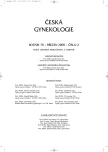-
Medical journals
- Career
Chlamydia Infections in Urogenital Tract – Application of Direct Immunofluorescence in the Diagnostics of Chlamydia trachomatis in the East Bohemian Region of Czech Republic during 1997–2003
Authors: M. Főrstl 1; V. Štěpánová 1; V. Buchta 1; I. Kalousek 2; J. Špaček 2; Z. Veselský 3; P. Macek 4; M. Chrzová 5
Authors‘ workplace: Ústav klinické mikrobiologie FN a LF UK, Hradec Králové 1; Porodnická a gynekologická klinika FN a LF UK, Hradec Králové 2; Urocentrum, Praha 3; Urologická klinka VFN a 1. LF UK, Praha 4; Katedra technických předmětů PdF LF UK, Hradec Králové 5
Published in: Ceska Gynekol 2005; 70(2): 128-133
Category: Original Article
Overview
Objective:
The aim of the study was an evaluation of results of Chlamydia trachomatis antigen detection by means of direct immunofluorescence in samples from patients suspected from this infection.Design:
Retrospective study.Setting:
Institute of clinical microbiology, University Hospital and Medical Faculty of Charles University, Hradec Králové.Methods:
Samples from females were swabs from uterine cervix, vagina and urethra, from male urethral swabs; moreover conjunctival swabs, bronchoalveolar irrigation, lower respiratory tract aspirates and sputum. Samples were fixed and „dyed” with monoclonal specific antibody labeled by fluorescent dye in the lab with a commercial diagnostic kit and they were evaluated microscopically after adding a drop of glycerol and covering with a top slide.Results:
Within a group of 6126 samples from patients suspected from Chlamydia infection we have found positivity in 14.4 %. Of this subgroup 14.1 % in samples from genitourinary tract of females and 15.2 % in males, 14.1 % from conjunctival swabs and 3.7 % from lower respiratory tract. According to an age differentiation, positive samples in individual life-decades from genitourinary tract were 0–13–14.4–13.9–13.9 and in females over 60 13.9 %. In males the corresponding walues were 0–21.4–15.1–16–13.4 and those over 60 years 16 %. So, the highest positivity in our region has been detected in samples from young men aged 20–30, where it is nearly two-fold higher comparison to age-matched females.Conclusion:
Direct detection of Chlamydia trachomatis antigen with immunofluorescence method still remains a reliable diagnostic tool. But for a control or confirmation of disputable results it is inconditionally necessary to have at least one more method available, e.g. PCR.Key words:
Chlamydia trachomatis, antigen detection, immunofluorescence, genitourinary tract, eye, conjunctiva, sputum, irrigation
Labels
Paediatric gynaecology Gynaecology and obstetrics Reproduction medicine
Article was published inCzech Gynaecology

2005 Issue 2-
All articles in this issue
- Clinical Experience with a Modified Method of Human Embryo Vitrification
- The Analysis of Preliminary Spermatological Parameters in Potential Donors of Semen
- Hormonal Suppression and Pubertal Development in Children with Central Precocious Puberty in the First Treatment Cycle 12 Weeks after Injection of Triptoreline 11.25 mg (Diphereline S. R. 11.25 mg): a Pilot Study
- Tumorous Diseases in Patients with the Testicular Feminization Syndrome („Androgen Insensitivity” Syndrome) - Description of Two Cases
- Abdominal Radical Trachelectomy – Technique and Experience
- Correlation of Urethral Mobility and Urethral Closure Pressure or Valsalva Leak-Point Pressure in Patients with Genuine Stress Incontinence
- Chlamydia Infections in Urogenital Tract – Application of Direct Immunofluorescence in the Diagnostics of Chlamydia trachomatis in the East Bohemian Region of Czech Republic during 1997–2003
- The Frequency of Venous Thromboembolism in Women with F V Leiden in Association with Pregnancy and Puerperium
- Coagulation Factor VIII in the Early Postpartum Period
- Successful Treatment of Severe Post-partum Bleeding after Caesarean Section Using Recombinant Activated Factor VII
- Delivery of a Healthy Child from Pregnancy after IVF Complicated Hyperstimulation Syndrome, Phlebothrombosis and Resection of Uterine Horn
- Endometriosis Immitating Bladder Tumor in 2nd Trimester of Pregnancy
- Giant Benign Mucinous Cystadenoma of Both Ovaries in Early Puerperium: Case Report and Review of Literature
- Deficient Intake of Nutrients and the Resulting Health Complications in Vegetarians in the Course of Pregnancy and Lactation
- The Management of Uterine Fibroids: CSGE Clinical Practice Guidelines
- Morgagni Cyst within Tubal Lipoma
- Czech Gynaecology
- Journal archive
- Current issue
- Online only
- About the journal
Most read in this issue- Coagulation Factor VIII in the Early Postpartum Period
- Abdominal Radical Trachelectomy – Technique and Experience
- Morgagni Cyst within Tubal Lipoma
- Giant Benign Mucinous Cystadenoma of Both Ovaries in Early Puerperium: Case Report and Review of Literature
Login#ADS_BOTTOM_SCRIPTS#Forgotten passwordEnter the email address that you registered with. We will send you instructions on how to set a new password.
- Career

